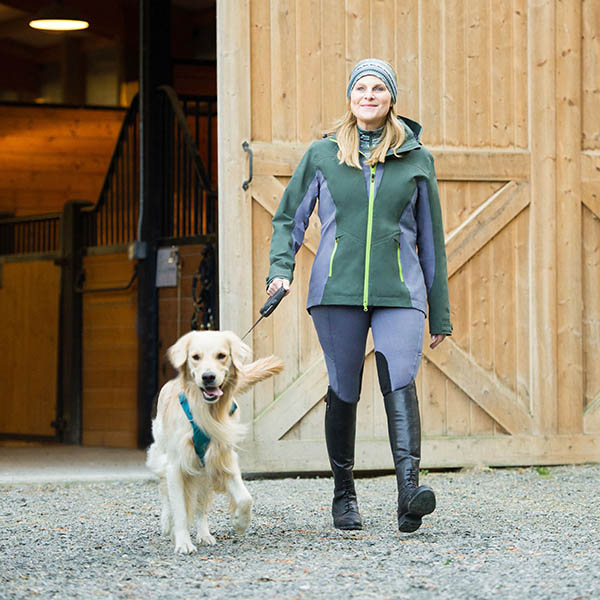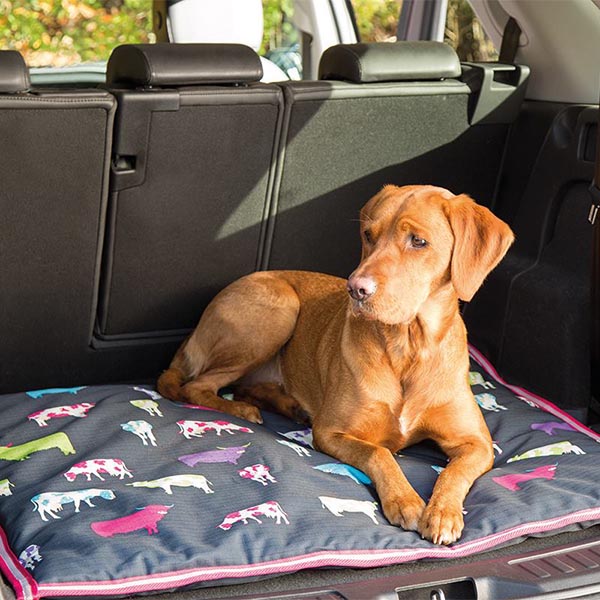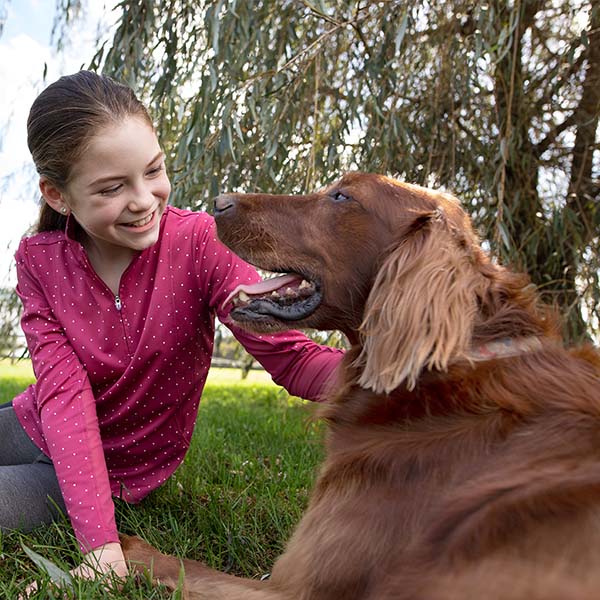
Many equestrians like to bring their dogs to the barn with them when they spend time with their horses at boarding barns, especially those who plan to spend the day at the farm riding and caring for their horse and visiting with their barn mates. Bringing your canine companion with you to the barn can be an enjoyable shared experience for both of you, however, without proper preparation or planning, it can also have negative consequences for you, your dog, the horses, and other equestrians. Keep reading to learn more about the guidelines you would need to bring your dog along with you to make the barn visit a positive experience for everyone.
Rules of the Individual Barn
First, it is absolutely essential that you ask an authority figure at the barn for permission to bring your dog to the farm. Every barn has different rules regarding equestrians’ dogs and it is important that you follow them for everyone’s safety. Do not assume that you are allowed to bring your dog simply because you see other dogs at the farm. Speaking with the property owner, barn manager, or head trainer/instructor is the only way to ensure clear communication and to make sure that you are all on the same page regarding rules and expectations.
Every barn has different rules and regulations regarding the dogs on the property, but here are some common ones:
- Dogs should remain on a leash at all times.
- Unruly dogs should be removed from the premises immediately.
- Dogs should stay outside the arena and/or the horses’ stalls.
- Dogs should not chase horses or other animals.
- Dogs must be picked-up after.
- Dogs should always be fully vaccinated and registered.
Always make sure that you follow the specific rules of your barn to ensure that your dog remains welcome. While it is fun to bring your dog to the barn, the underlying thought should always be that the barn is the horses’ place. If your dog does not act appropriately and in a way to facilitate a safe interaction for the horses, livestock, and equestrians around them, they should remain at home.
Additionally, it is essential to discuss the risks of having your dog on the farm. Who will be liable if your dog causes an injury to a horse, person, dog, etc.? Will the farm insurance cover any potential accidents? By having an understanding of the liabilities associated with your dog’s presence at the farm, you can make decisions regarding when and if you should bring him or her.
Expected Behaviors for a Dog at the Barn
Before you even consider bringing your dog to the barn, it is important to have an understanding of your end goal. While we all want our dogs to be “good” at the barn, what does that mean exactly? A well-behaved dog at the barn is a dog that is respectful and quiet around horses, livestock, other dogs, and unfamiliar people (no jumping, chasing, barking, etc.). The dog should stay outside of all riding rings, round pens, indoor arenas, etc. because running through the facilities can be incredibly dangerous, particularly if beginners are riding or there are green horses prone to spooking. It is important that the dog stay calm within the barn areas, such as the barn aisle and tack room, understanding that they are not allowed in the stalls with the horses. The dogs also need to come promptly when called so they must have excellent recall skills. These behaviors are especially important if you are planning to bring your dog to a public barn or a busy private barn.
Even if you have a well-behaved dog at home, you may discover that the barn is a whole new territory. Just as with your obedience training, you will need practice and repetition to properly infuse these principles into your dog’s behavior in a way that almost becomes second nature to them.
It is recommended that you keep your dog on a leash at all times. When you are first introducing them to the barn setting, you may want to consider a short leash for more control as they adjust to all the new situations. You may find that your barn allows for dogs to be off-leash, but this should only be done once your dog has shown reliable expected behavior in the barn surroundings. You may also want to work on the “buddy system” with one of your barn mates so that one of you can supervise the dogs while the other rides, and vice versa. There may be an exception to this rule, in the instance of bringing your dog trail riding with you, but this should only be done after you have spent the requisite amount of time introducing your dog to the barn life and everything that comes with it.

Dogs should always be contained (such as in a crate or empty stall) or tied whenever you are unable to supervise them, for example, when you are riding your horse or grooming your horse. Make this area comfortable and personalized by providing them with a durable waterproof bed and mental stimulation, such as a marrow bone or a chew toy, like the Wacky Walk’r Wunderball Dog Toy or the Benebone Dental Chew. Many popular equestrian brands, like Shires, Ariat, and Horseware, make rugged clothing, beds, and gear for dogs as well. The Shires Waterproof Dog Bed is an employee favorite. Morgan Monty, our Pet Sales Manager, explains, “It is waterproof, easy to clean, and very durable. I like that it gives them a safe place to lay and sit, perhaps even chew a bone without being on the hard floor or cold cement.” For barn time in the winter months, you may notice that your dog is chilly; provide them with a waterproof, insulated coat to keep your pup warm and cozy.
Depending on the weather, some equestrians may choose to keep their dogs in their car when they are riding. In order to ensure your dog’s safety, it is imperative that you monitor the temperature extremely closely, as temperatures can quickly rise to unsafe levels. Some dog owners chose to utilize a crate in the back of their SUV so that they can leave the tailgate open and therefore allow for temperature regulation.
After their visit, many dogs will need to be bathed or spot cleaned, depending on their breed and coat type. Make sure that you have the necessary products on hand (such as brushes, shampoos, and spot cleaners), so that you are prepared to handle the potential dirt, mud, manure, and shavings that your dog could bring home with them.
Your Dog’s First Visit
Once you have the end goal in mind, you can consider how you would like to introduce your dog to the farm setting. Consider speaking with the barn manager to see what they would recommend for the dog’s first visit. They may have ideas about what to show them and where to put the dog if they become overwhelmed. Many barn owners, instructors, and horse trainers are also dog lovers and want to make sure that this first visit is successful. They also may have ideas about what has worked for other dogs of similar demeanors in the past.

After you have received their thoughts, it is a good idea to walk the property to get an idea of what challenges your dog may encounter at the barn. You may discover that some of the new stimuli, for example, cats or chickens, can be introduced to your dog ahead, perhaps in your neighborhood. The more things that you can expose your dog to ahead of time, the easier it will be for them to become calm and comfortable at the barn.
Many dogs are also apprehensive about new people, particularly if they are wearing helmets or Western hats. It may behoove you to introduce your dog to this headgear before you enter the barn setting so that they can become familiar with it. Make sure that you explain to your other barn mates that you are introducing your dog to the farm for the first time so that they can act accordingly and allow the dog to approach them. It is also important to note that not all people are comfortable with dogs and may choose to stay away from your dog, make a plan as to how you will respect their wishes prior to visiting.
Once you have formulated a plan for your visit, bring your dog to the barn for a short period of time (typically 10-20 minutes is sufficient for their first introduction). Walk your dog, on a short leash, around the property, introducing him or her to the new surroundings. Many equestrians find that this is an appropriate time to introduce their dog to an animal-tolerant horse and observe the dog, watching to see what their reactions will be. Never force your dog to move closer to the horse if they seem uncomfortable, instead, allow them to observe the horse from a distance to allow them to become familiar with this large animal. By moving slowly and not rushing, you can help your dog to become comfortable and confident, without becoming overwhelmed. It may take more than one conditioning session before they are able to be introduced to another stimulus and this is to be expected. Keep the sessions short at first and allow your dog’s behavior to guide you.
Some dog owners choose to utilize training treats to reward their dogs for wanted behaviors, while others may choose to use praise. All of these methods are effective, provided you are consistent. By rewarding your dog when they are calm and relaxed in the barnyard setting, they will quickly learn what is expected of them and settle into their new environment. Repeat this process with each new situation, including goats, chickens, barn cats, other dogs, etc. This is overwhelming to many dogs at first, but if you are slow and methodical in your approach, they will rapidly gain confidence.
Potential Dangers at the Barn
When bringing your dog to the barn and being aware of keeping horses and riders safe around you, it is essential to be on the lookout for potential dangers for your dog as well. There are a number of hazardous conditions that your dog could experience in these new surroundings, including:
Horses
While dogs can be dangerous to horses (chasing them, biting them, scaring them, etc.), horses can also be extremely dangerous to dogs. Being kicked, stepped on, or bitten by a horse can be a very serious injury or even fatal for your dog. Be sure that you keep your dog at an appropriate distance away from the horses and out of harm’s way.
Farm Machinery
Large farm machinery, such as tractors, ATVs, and gators can cause serious injury to your dog. Just as you would keep your dog away from cars and trucks, you should do the same with farm machinery.
Ivermectin Poisoning
Some dogs are unable to process Ivermectin (a popular dewormer) in their systems and it can become toxic to them in larger doses. As a general rule, discourage your dog from eating manure, but you should be extra vigilant after the horses have been dewormed. Symptoms of Ivermectin poisoning include fatigue, vomiting, inability to stand, loss of appetite, dilated pupils, and tremors and seizures. You should contact your emergency veterinarian immediately if you suspect ivermectin poisoning.
Toxic Chemicals
In addition to deworming products, there are a number of other chemicals that could be toxic to your canine companion. Grooming products, supplements, fly control products, etc., all have the potential to harm your dog. Make sure that your dog is not getting into anything that they shouldn’t be in order to keep them safe.
Increased Risk of Internal Parasites
Barns have many animals convening in one location (along with their manure), this makes it an ideal location for internal parasites to thrive. If your dog frequents the barn, you will want to work with your veterinarian for testing looking for coccidia and tapeworms as well as the standard internal parasites.
Fleas and Ticks
Ticks can also be found around farms. Make sure that you check your dog for ticks on a daily basis, removing any ticks that you may find as soon as possible. You will also want to monitor your dogs for signs of tick-borne illnesses, such as Lyme’s Disease, Ehrlichiosis, Anaplasmosis, or Hepatozoonosis. Keeping up on a flea and tick regimen is recommended for all dogs, but it is especially important for barn dogs. We have a large selection of collars, spot-on, and internal treatments to help you stop ticks in their tracks.
Insects
In addition to ticks, it is important to monitor the area for biting insects such as barn flies and mosquitos. Flying insects are generally more present in the barn and around the farm, so sometimes a fly repellent for your dogs is necessary. Some of our customers utilize reflective coats and bandanas that are treated with permethrin to prevent flies and ticks on the dogs, like the No Fly Zone Tick Repelling Sport Dog Vest. Others prefer fly sprays that are also labeled safe for canine use, such as Manna Pro Pro-Force Fly Spray and UltraShield EX Flea & Tick Control for Dogs.
Observation and Patience with Your Pup

It is important to treat your dog as an individual and assess what they are trying to tell you every time you go to the barn. Was it enjoyable for you to bring your dog with you? Does your dog improve from visit to visit if still adjusting? Did your dog enjoy his visit and listen to your directions? Was he fearful of the new animals and situations or seemed unhappy? Are you worn out from trying to control your dog? Carefully evaluate your dog’s behavior to make sure that going to the barn is appropriate for their individual needs. For example, if you find yourself confining your dog for the duration of a long barn visit, does it make sense to continue to bring them with you?
It may take time to train your dog to become comfortable with the idea of coming to the barn with you, and that is ok; frankly, it is to be expected. Just like you dedicated time to teaching your dog how to properly act in your household, you will need to allocate sufficient time to educate your dog about proper barnyard behavior. The reward is worth it, however — a well-behaved dog who likes spending time at the barn almost as much as you do!
